Phase Change Material and Green Rooftop: A Sustainable Approach
VerifiedAdded on 2020/04/07
|43
|10630
|47
Report
AI Summary
This report investigates the collaboration of Phase Change Material (PCM) and green rooftops as a sustainable approach to building design and energy efficiency. It begins with an introduction to the current climate change challenges, emphasizing the depletion of natural resources and the need for sustainable solutions in architecture. The report explores the principles of PCM, including its thermal energy storage capabilities, critical material properties, and integration strategies within buildings. It then examines the applications of PCM in green rooftops, discussing various models, commercial products, and their potential for reducing greenhouse gas emissions and fossil fuel consumption. The literature review covers latent heat storage, critical material properties, and the properties of PCM and green systems contributing to energy balance analysis. Finally, it presents methodologies for modeling PCM-integrated buildings and simulations, providing a comprehensive overview of the benefits and applications of this innovative technology in addressing urban climate change and promoting sustainable building practices. The report highlights the potential for PCM and green rooftops to mitigate the effects of heat islands, lower air temperatures, and create more sustainable and energy-efficient buildings. This document is contributed by a student to be published on the website Desklib, a platform which provides all the necessary AI based study tools for students.
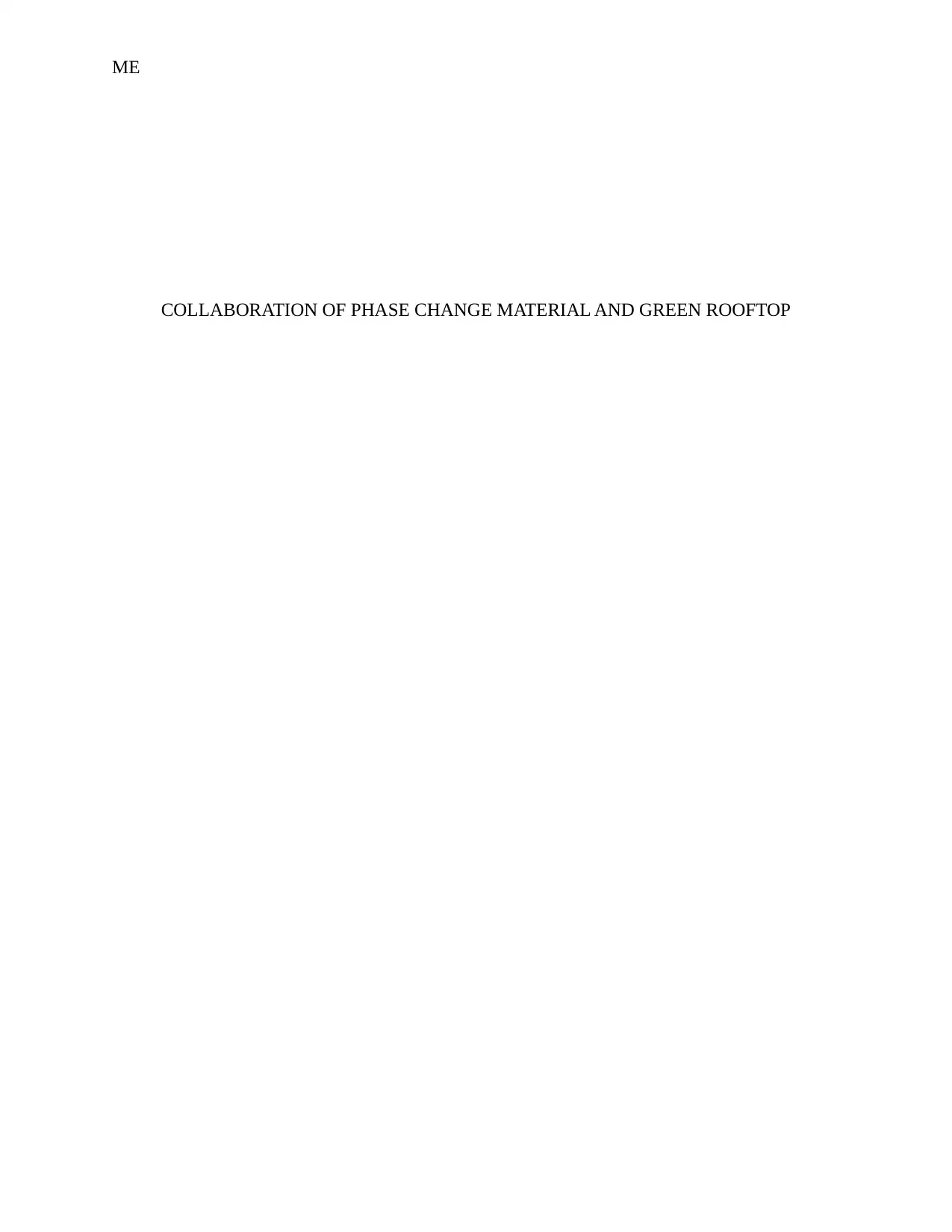
ME
COLLABORATION OF PHASE CHANGE MATERIAL AND GREEN ROOFTOP
COLLABORATION OF PHASE CHANGE MATERIAL AND GREEN ROOFTOP
Paraphrase This Document
Need a fresh take? Get an instant paraphrase of this document with our AI Paraphraser
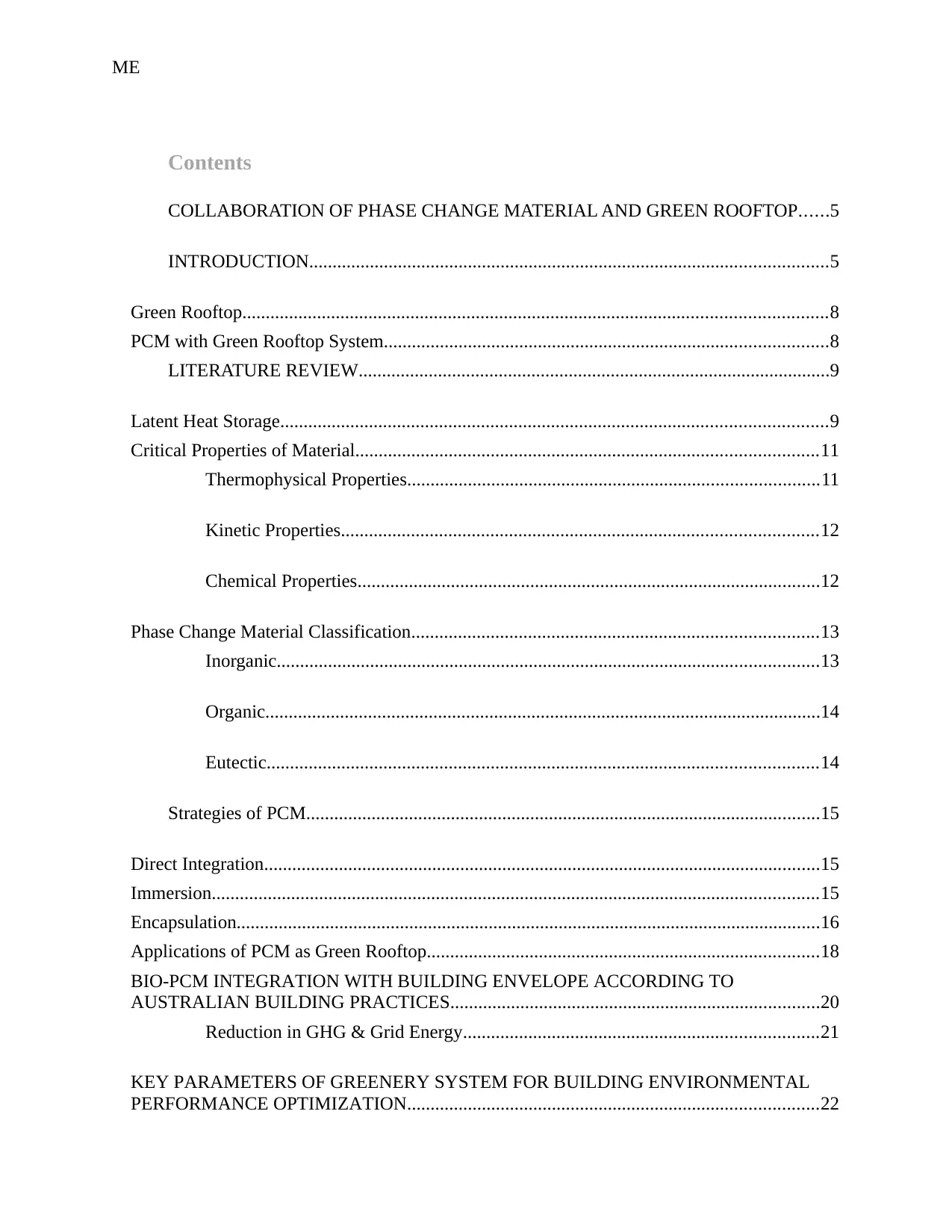
ME
Contents
COLLABORATION OF PHASE CHANGE MATERIAL AND GREEN ROOFTOP......5
INTRODUCTION...............................................................................................................5
Green Rooftop.............................................................................................................................8
PCM with Green Rooftop System...............................................................................................8
LITERATURE REVIEW.....................................................................................................9
Latent Heat Storage.....................................................................................................................9
Critical Properties of Material...................................................................................................11
Thermophysical Properties........................................................................................11
Kinetic Properties......................................................................................................12
Chemical Properties...................................................................................................12
Phase Change Material Classification.......................................................................................13
Inorganic....................................................................................................................13
Organic.......................................................................................................................14
Eutectic......................................................................................................................14
Strategies of PCM..............................................................................................................15
Direct Integration.......................................................................................................................15
Immersion..................................................................................................................................15
Encapsulation.............................................................................................................................16
Applications of PCM as Green Rooftop....................................................................................18
BIO-PCM INTEGRATION WITH BUILDING ENVELOPE ACCORDING TO
AUSTRALIAN BUILDING PRACTICES...............................................................................20
Reduction in GHG & Grid Energy............................................................................21
KEY PARAMETERS OF GREENERY SYSTEM FOR BUILDING ENVIRONMENTAL
PERFORMANCE OPTIMIZATION........................................................................................22
Contents
COLLABORATION OF PHASE CHANGE MATERIAL AND GREEN ROOFTOP......5
INTRODUCTION...............................................................................................................5
Green Rooftop.............................................................................................................................8
PCM with Green Rooftop System...............................................................................................8
LITERATURE REVIEW.....................................................................................................9
Latent Heat Storage.....................................................................................................................9
Critical Properties of Material...................................................................................................11
Thermophysical Properties........................................................................................11
Kinetic Properties......................................................................................................12
Chemical Properties...................................................................................................12
Phase Change Material Classification.......................................................................................13
Inorganic....................................................................................................................13
Organic.......................................................................................................................14
Eutectic......................................................................................................................14
Strategies of PCM..............................................................................................................15
Direct Integration.......................................................................................................................15
Immersion..................................................................................................................................15
Encapsulation.............................................................................................................................16
Applications of PCM as Green Rooftop....................................................................................18
BIO-PCM INTEGRATION WITH BUILDING ENVELOPE ACCORDING TO
AUSTRALIAN BUILDING PRACTICES...............................................................................20
Reduction in GHG & Grid Energy............................................................................21
KEY PARAMETERS OF GREENERY SYSTEM FOR BUILDING ENVIRONMENTAL
PERFORMANCE OPTIMIZATION........................................................................................22
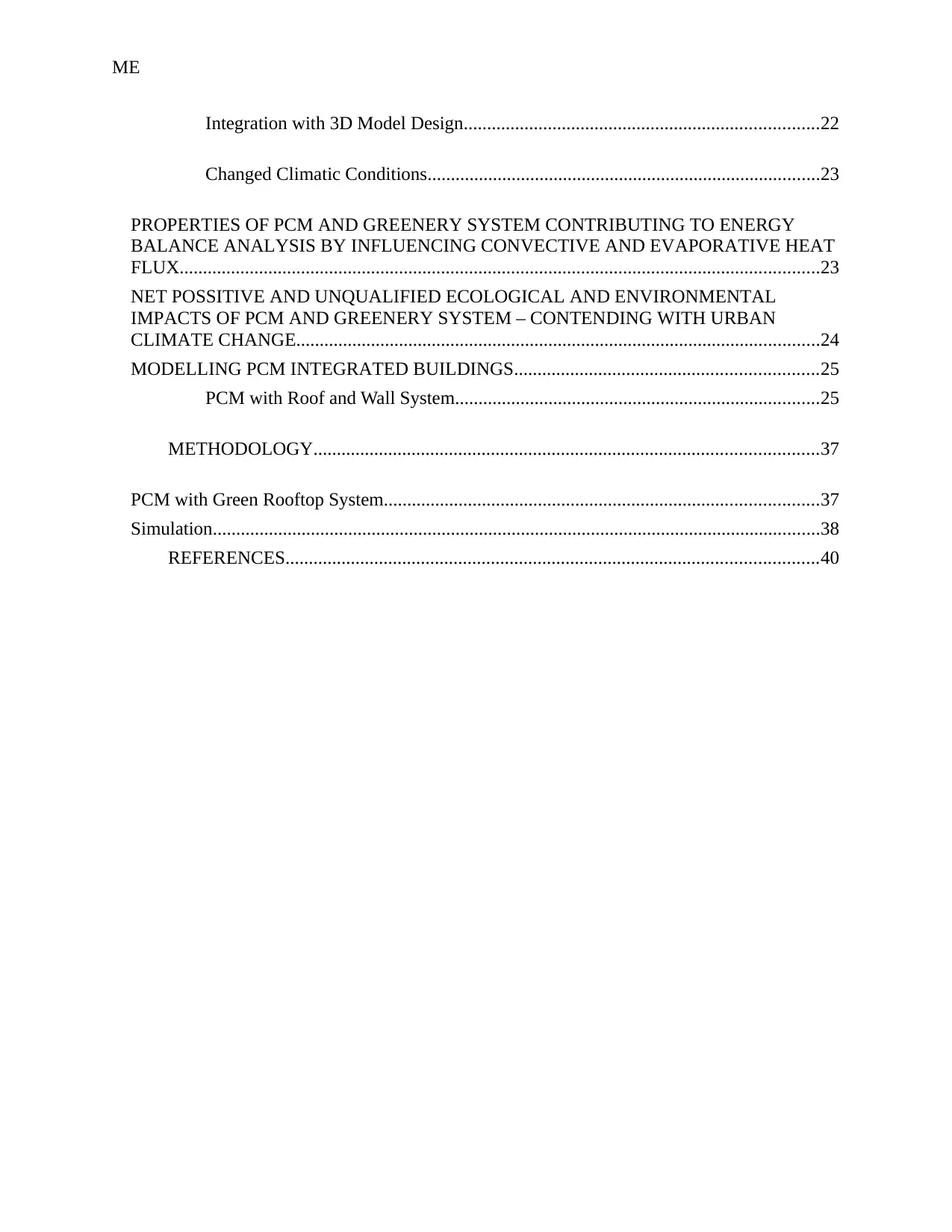
ME
Integration with 3D Model Design............................................................................22
Changed Climatic Conditions....................................................................................23
PROPERTIES OF PCM AND GREENERY SYSTEM CONTRIBUTING TO ENERGY
BALANCE ANALYSIS BY INFLUENCING CONVECTIVE AND EVAPORATIVE HEAT
FLUX.........................................................................................................................................23
NET POSSITIVE AND UNQUALIFIED ECOLOGICAL AND ENVIRONMENTAL
IMPACTS OF PCM AND GREENERY SYSTEM – CONTENDING WITH URBAN
CLIMATE CHANGE................................................................................................................24
MODELLING PCM INTEGRATED BUILDINGS.................................................................25
PCM with Roof and Wall System..............................................................................25
METHODOLOGY............................................................................................................37
PCM with Green Rooftop System.............................................................................................37
Simulation..................................................................................................................................38
REFERENCES..................................................................................................................40
Integration with 3D Model Design............................................................................22
Changed Climatic Conditions....................................................................................23
PROPERTIES OF PCM AND GREENERY SYSTEM CONTRIBUTING TO ENERGY
BALANCE ANALYSIS BY INFLUENCING CONVECTIVE AND EVAPORATIVE HEAT
FLUX.........................................................................................................................................23
NET POSSITIVE AND UNQUALIFIED ECOLOGICAL AND ENVIRONMENTAL
IMPACTS OF PCM AND GREENERY SYSTEM – CONTENDING WITH URBAN
CLIMATE CHANGE................................................................................................................24
MODELLING PCM INTEGRATED BUILDINGS.................................................................25
PCM with Roof and Wall System..............................................................................25
METHODOLOGY............................................................................................................37
PCM with Green Rooftop System.............................................................................................37
Simulation..................................................................................................................................38
REFERENCES..................................................................................................................40
⊘ This is a preview!⊘
Do you want full access?
Subscribe today to unlock all pages.

Trusted by 1+ million students worldwide
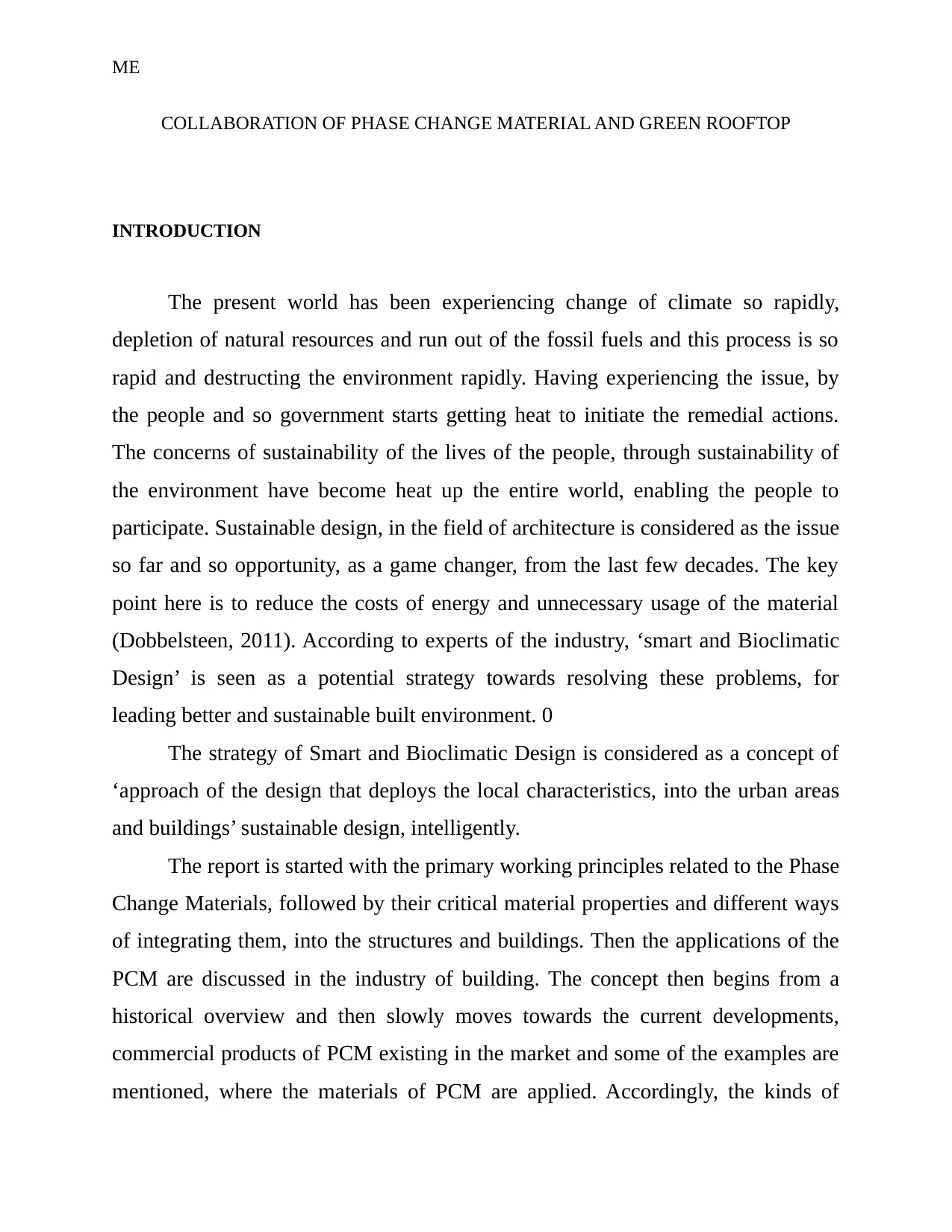
ME
COLLABORATION OF PHASE CHANGE MATERIAL AND GREEN ROOFTOP
INTRODUCTION
The present world has been experiencing change of climate so rapidly,
depletion of natural resources and run out of the fossil fuels and this process is so
rapid and destructing the environment rapidly. Having experiencing the issue, by
the people and so government starts getting heat to initiate the remedial actions.
The concerns of sustainability of the lives of the people, through sustainability of
the environment have become heat up the entire world, enabling the people to
participate. Sustainable design, in the field of architecture is considered as the issue
so far and so opportunity, as a game changer, from the last few decades. The key
point here is to reduce the costs of energy and unnecessary usage of the material
(Dobbelsteen, 2011). According to experts of the industry, ‘smart and Bioclimatic
Design’ is seen as a potential strategy towards resolving these problems, for
leading better and sustainable built environment. 0
The strategy of Smart and Bioclimatic Design is considered as a concept of
‘approach of the design that deploys the local characteristics, into the urban areas
and buildings’ sustainable design, intelligently.
The report is started with the primary working principles related to the Phase
Change Materials, followed by their critical material properties and different ways
of integrating them, into the structures and buildings. Then the applications of the
PCM are discussed in the industry of building. The concept then begins from a
historical overview and then slowly moves towards the current developments,
commercial products of PCM existing in the market and some of the examples are
mentioned, where the materials of PCM are applied. Accordingly, the kinds of
COLLABORATION OF PHASE CHANGE MATERIAL AND GREEN ROOFTOP
INTRODUCTION
The present world has been experiencing change of climate so rapidly,
depletion of natural resources and run out of the fossil fuels and this process is so
rapid and destructing the environment rapidly. Having experiencing the issue, by
the people and so government starts getting heat to initiate the remedial actions.
The concerns of sustainability of the lives of the people, through sustainability of
the environment have become heat up the entire world, enabling the people to
participate. Sustainable design, in the field of architecture is considered as the issue
so far and so opportunity, as a game changer, from the last few decades. The key
point here is to reduce the costs of energy and unnecessary usage of the material
(Dobbelsteen, 2011). According to experts of the industry, ‘smart and Bioclimatic
Design’ is seen as a potential strategy towards resolving these problems, for
leading better and sustainable built environment. 0
The strategy of Smart and Bioclimatic Design is considered as a concept of
‘approach of the design that deploys the local characteristics, into the urban areas
and buildings’ sustainable design, intelligently.
The report is started with the primary working principles related to the Phase
Change Materials, followed by their critical material properties and different ways
of integrating them, into the structures and buildings. Then the applications of the
PCM are discussed in the industry of building. The concept then begins from a
historical overview and then slowly moves towards the current developments,
commercial products of PCM existing in the market and some of the examples are
mentioned, where the materials of PCM are applied. Accordingly, the kinds of
Paraphrase This Document
Need a fresh take? Get an instant paraphrase of this document with our AI Paraphraser
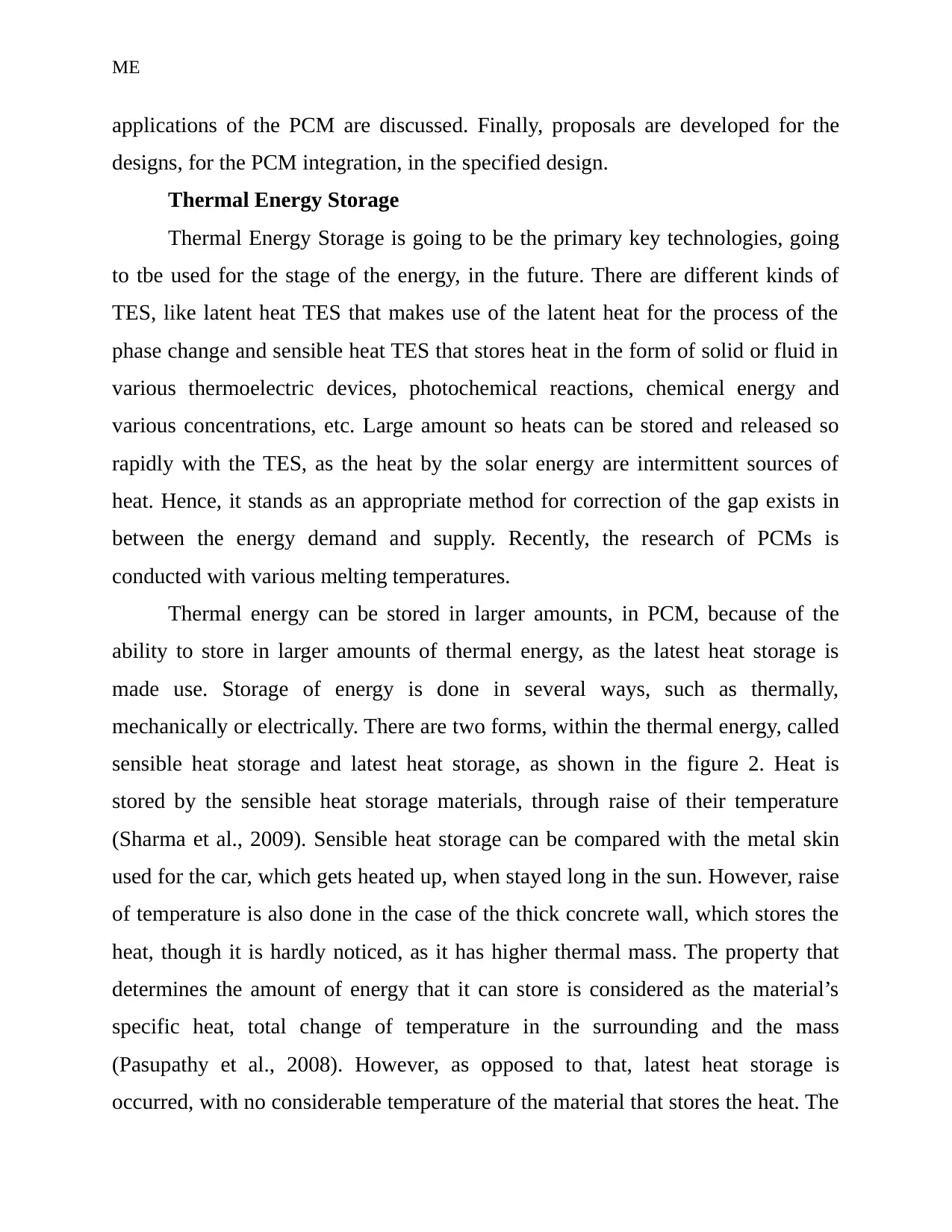
ME
applications of the PCM are discussed. Finally, proposals are developed for the
designs, for the PCM integration, in the specified design.
Thermal Energy Storage
Thermal Energy Storage is going to be the primary key technologies, going
to tbe used for the stage of the energy, in the future. There are different kinds of
TES, like latent heat TES that makes use of the latent heat for the process of the
phase change and sensible heat TES that stores heat in the form of solid or fluid in
various thermoelectric devices, photochemical reactions, chemical energy and
various concentrations, etc. Large amount so heats can be stored and released so
rapidly with the TES, as the heat by the solar energy are intermittent sources of
heat. Hence, it stands as an appropriate method for correction of the gap exists in
between the energy demand and supply. Recently, the research of PCMs is
conducted with various melting temperatures.
Thermal energy can be stored in larger amounts, in PCM, because of the
ability to store in larger amounts of thermal energy, as the latest heat storage is
made use. Storage of energy is done in several ways, such as thermally,
mechanically or electrically. There are two forms, within the thermal energy, called
sensible heat storage and latest heat storage, as shown in the figure 2. Heat is
stored by the sensible heat storage materials, through raise of their temperature
(Sharma et al., 2009). Sensible heat storage can be compared with the metal skin
used for the car, which gets heated up, when stayed long in the sun. However, raise
of temperature is also done in the case of the thick concrete wall, which stores the
heat, though it is hardly noticed, as it has higher thermal mass. The property that
determines the amount of energy that it can store is considered as the material’s
specific heat, total change of temperature in the surrounding and the mass
(Pasupathy et al., 2008). However, as opposed to that, latest heat storage is
occurred, with no considerable temperature of the material that stores the heat. The
applications of the PCM are discussed. Finally, proposals are developed for the
designs, for the PCM integration, in the specified design.
Thermal Energy Storage
Thermal Energy Storage is going to be the primary key technologies, going
to tbe used for the stage of the energy, in the future. There are different kinds of
TES, like latent heat TES that makes use of the latent heat for the process of the
phase change and sensible heat TES that stores heat in the form of solid or fluid in
various thermoelectric devices, photochemical reactions, chemical energy and
various concentrations, etc. Large amount so heats can be stored and released so
rapidly with the TES, as the heat by the solar energy are intermittent sources of
heat. Hence, it stands as an appropriate method for correction of the gap exists in
between the energy demand and supply. Recently, the research of PCMs is
conducted with various melting temperatures.
Thermal energy can be stored in larger amounts, in PCM, because of the
ability to store in larger amounts of thermal energy, as the latest heat storage is
made use. Storage of energy is done in several ways, such as thermally,
mechanically or electrically. There are two forms, within the thermal energy, called
sensible heat storage and latest heat storage, as shown in the figure 2. Heat is
stored by the sensible heat storage materials, through raise of their temperature
(Sharma et al., 2009). Sensible heat storage can be compared with the metal skin
used for the car, which gets heated up, when stayed long in the sun. However, raise
of temperature is also done in the case of the thick concrete wall, which stores the
heat, though it is hardly noticed, as it has higher thermal mass. The property that
determines the amount of energy that it can store is considered as the material’s
specific heat, total change of temperature in the surrounding and the mass
(Pasupathy et al., 2008). However, as opposed to that, latest heat storage is
occurred, with no considerable temperature of the material that stores the heat. The
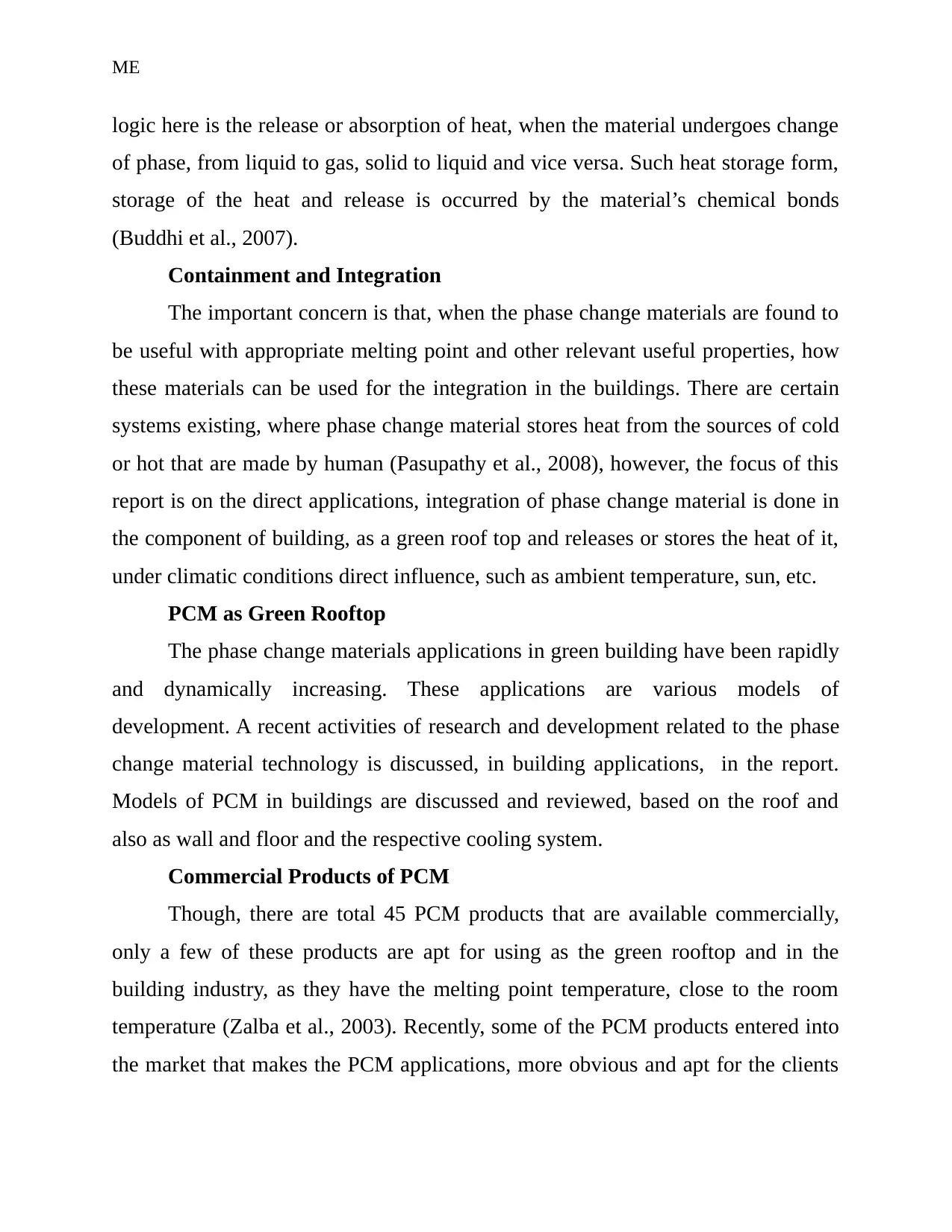
ME
logic here is the release or absorption of heat, when the material undergoes change
of phase, from liquid to gas, solid to liquid and vice versa. Such heat storage form,
storage of the heat and release is occurred by the material’s chemical bonds
(Buddhi et al., 2007).
Containment and Integration
The important concern is that, when the phase change materials are found to
be useful with appropriate melting point and other relevant useful properties, how
these materials can be used for the integration in the buildings. There are certain
systems existing, where phase change material stores heat from the sources of cold
or hot that are made by human (Pasupathy et al., 2008), however, the focus of this
report is on the direct applications, integration of phase change material is done in
the component of building, as a green roof top and releases or stores the heat of it,
under climatic conditions direct influence, such as ambient temperature, sun, etc.
PCM as Green Rooftop
The phase change materials applications in green building have been rapidly
and dynamically increasing. These applications are various models of
development. A recent activities of research and development related to the phase
change material technology is discussed, in building applications, in the report.
Models of PCM in buildings are discussed and reviewed, based on the roof and
also as wall and floor and the respective cooling system.
Commercial Products of PCM
Though, there are total 45 PCM products that are available commercially,
only a few of these products are apt for using as the green rooftop and in the
building industry, as they have the melting point temperature, close to the room
temperature (Zalba et al., 2003). Recently, some of the PCM products entered into
the market that makes the PCM applications, more obvious and apt for the clients
logic here is the release or absorption of heat, when the material undergoes change
of phase, from liquid to gas, solid to liquid and vice versa. Such heat storage form,
storage of the heat and release is occurred by the material’s chemical bonds
(Buddhi et al., 2007).
Containment and Integration
The important concern is that, when the phase change materials are found to
be useful with appropriate melting point and other relevant useful properties, how
these materials can be used for the integration in the buildings. There are certain
systems existing, where phase change material stores heat from the sources of cold
or hot that are made by human (Pasupathy et al., 2008), however, the focus of this
report is on the direct applications, integration of phase change material is done in
the component of building, as a green roof top and releases or stores the heat of it,
under climatic conditions direct influence, such as ambient temperature, sun, etc.
PCM as Green Rooftop
The phase change materials applications in green building have been rapidly
and dynamically increasing. These applications are various models of
development. A recent activities of research and development related to the phase
change material technology is discussed, in building applications, in the report.
Models of PCM in buildings are discussed and reviewed, based on the roof and
also as wall and floor and the respective cooling system.
Commercial Products of PCM
Though, there are total 45 PCM products that are available commercially,
only a few of these products are apt for using as the green rooftop and in the
building industry, as they have the melting point temperature, close to the room
temperature (Zalba et al., 2003). Recently, some of the PCM products entered into
the market that makes the PCM applications, more obvious and apt for the clients
⊘ This is a preview!⊘
Do you want full access?
Subscribe today to unlock all pages.

Trusted by 1+ million students worldwide
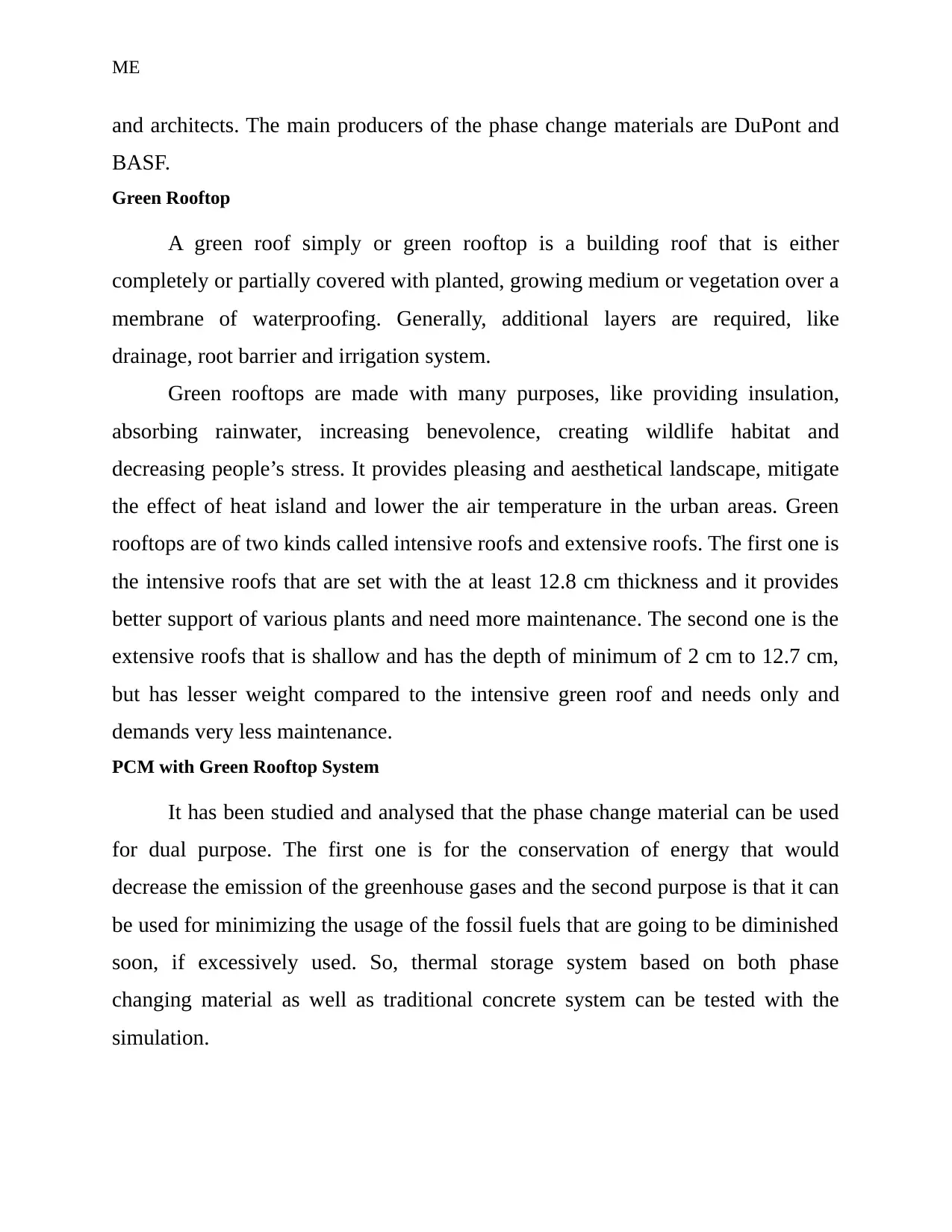
ME
and architects. The main producers of the phase change materials are DuPont and
BASF.
Green Rooftop
A green roof simply or green rooftop is a building roof that is either
completely or partially covered with planted, growing medium or vegetation over a
membrane of waterproofing. Generally, additional layers are required, like
drainage, root barrier and irrigation system.
Green rooftops are made with many purposes, like providing insulation,
absorbing rainwater, increasing benevolence, creating wildlife habitat and
decreasing people’s stress. It provides pleasing and aesthetical landscape, mitigate
the effect of heat island and lower the air temperature in the urban areas. Green
rooftops are of two kinds called intensive roofs and extensive roofs. The first one is
the intensive roofs that are set with the at least 12.8 cm thickness and it provides
better support of various plants and need more maintenance. The second one is the
extensive roofs that is shallow and has the depth of minimum of 2 cm to 12.7 cm,
but has lesser weight compared to the intensive green roof and needs only and
demands very less maintenance.
PCM with Green Rooftop System
It has been studied and analysed that the phase change material can be used
for dual purpose. The first one is for the conservation of energy that would
decrease the emission of the greenhouse gases and the second purpose is that it can
be used for minimizing the usage of the fossil fuels that are going to be diminished
soon, if excessively used. So, thermal storage system based on both phase
changing material as well as traditional concrete system can be tested with the
simulation.
and architects. The main producers of the phase change materials are DuPont and
BASF.
Green Rooftop
A green roof simply or green rooftop is a building roof that is either
completely or partially covered with planted, growing medium or vegetation over a
membrane of waterproofing. Generally, additional layers are required, like
drainage, root barrier and irrigation system.
Green rooftops are made with many purposes, like providing insulation,
absorbing rainwater, increasing benevolence, creating wildlife habitat and
decreasing people’s stress. It provides pleasing and aesthetical landscape, mitigate
the effect of heat island and lower the air temperature in the urban areas. Green
rooftops are of two kinds called intensive roofs and extensive roofs. The first one is
the intensive roofs that are set with the at least 12.8 cm thickness and it provides
better support of various plants and need more maintenance. The second one is the
extensive roofs that is shallow and has the depth of minimum of 2 cm to 12.7 cm,
but has lesser weight compared to the intensive green roof and needs only and
demands very less maintenance.
PCM with Green Rooftop System
It has been studied and analysed that the phase change material can be used
for dual purpose. The first one is for the conservation of energy that would
decrease the emission of the greenhouse gases and the second purpose is that it can
be used for minimizing the usage of the fossil fuels that are going to be diminished
soon, if excessively used. So, thermal storage system based on both phase
changing material as well as traditional concrete system can be tested with the
simulation.
Paraphrase This Document
Need a fresh take? Get an instant paraphrase of this document with our AI Paraphraser
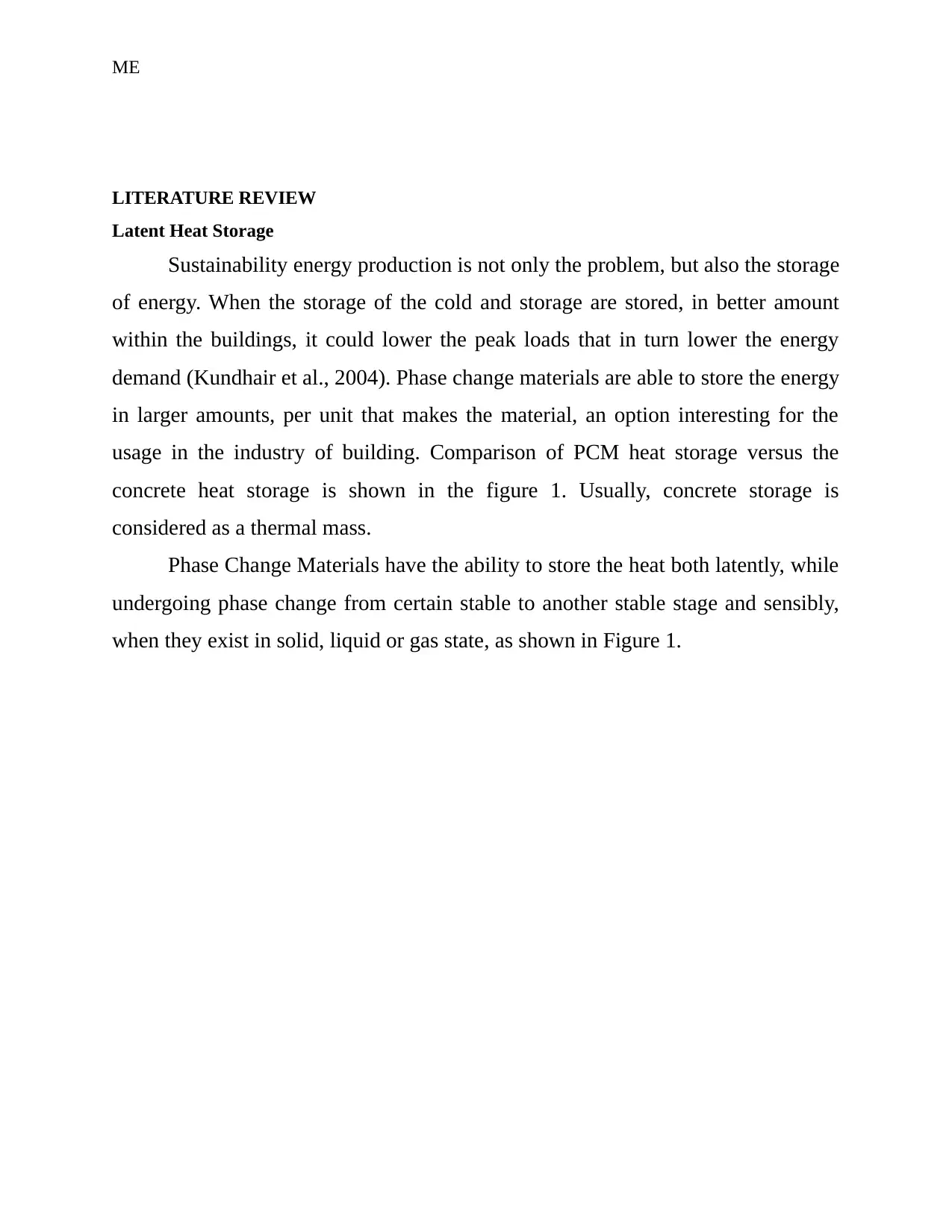
ME
LITERATURE REVIEW
Latent Heat Storage
Sustainability energy production is not only the problem, but also the storage
of energy. When the storage of the cold and storage are stored, in better amount
within the buildings, it could lower the peak loads that in turn lower the energy
demand (Kundhair et al., 2004). Phase change materials are able to store the energy
in larger amounts, per unit that makes the material, an option interesting for the
usage in the industry of building. Comparison of PCM heat storage versus the
concrete heat storage is shown in the figure 1. Usually, concrete storage is
considered as a thermal mass.
Phase Change Materials have the ability to store the heat both latently, while
undergoing phase change from certain stable to another stable stage and sensibly,
when they exist in solid, liquid or gas state, as shown in Figure 1.
LITERATURE REVIEW
Latent Heat Storage
Sustainability energy production is not only the problem, but also the storage
of energy. When the storage of the cold and storage are stored, in better amount
within the buildings, it could lower the peak loads that in turn lower the energy
demand (Kundhair et al., 2004). Phase change materials are able to store the energy
in larger amounts, per unit that makes the material, an option interesting for the
usage in the industry of building. Comparison of PCM heat storage versus the
concrete heat storage is shown in the figure 1. Usually, concrete storage is
considered as a thermal mass.
Phase Change Materials have the ability to store the heat both latently, while
undergoing phase change from certain stable to another stable stage and sensibly,
when they exist in solid, liquid or gas state, as shown in Figure 1.
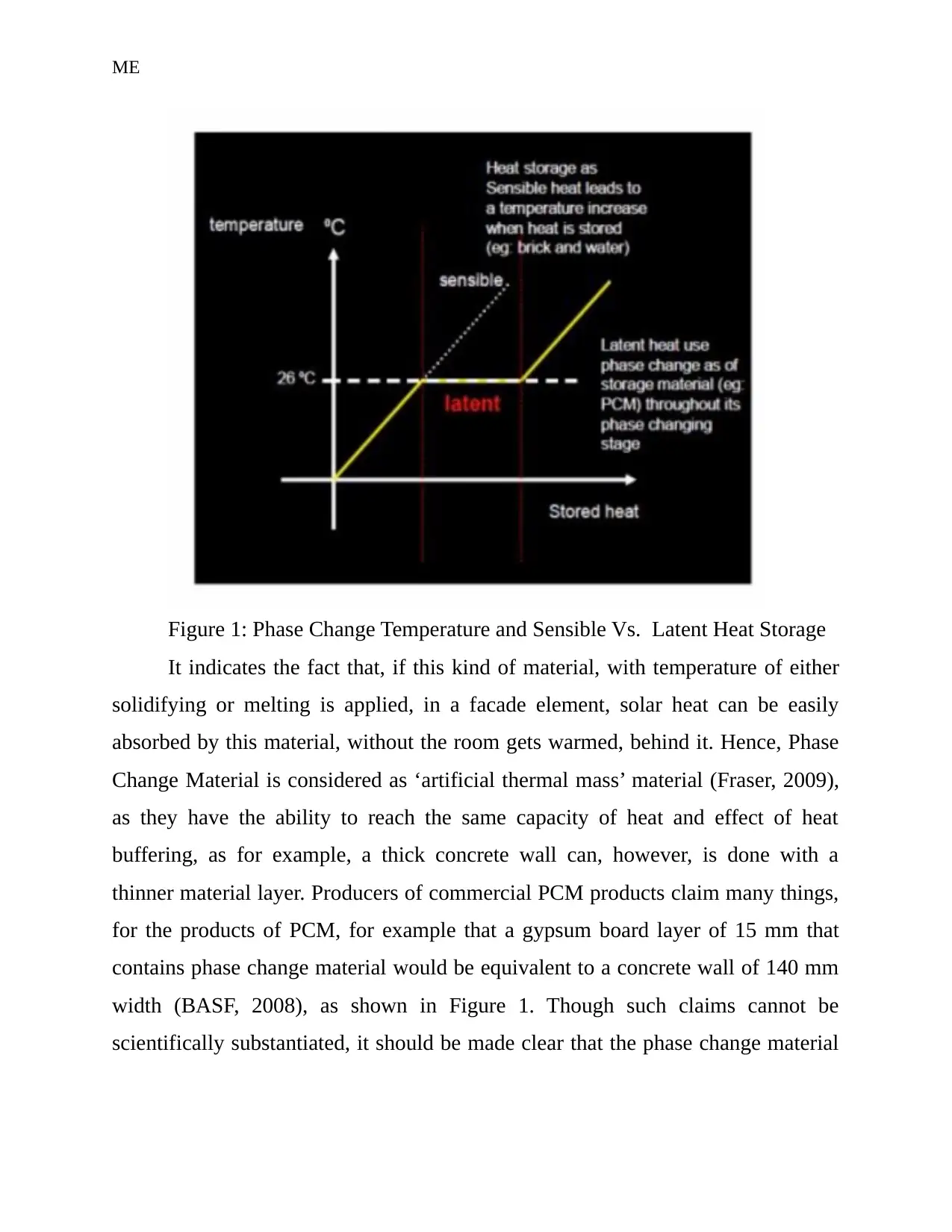
ME
Figure 1: Phase Change Temperature and Sensible Vs. Latent Heat Storage
It indicates the fact that, if this kind of material, with temperature of either
solidifying or melting is applied, in a facade element, solar heat can be easily
absorbed by this material, without the room gets warmed, behind it. Hence, Phase
Change Material is considered as ‘artificial thermal mass’ material (Fraser, 2009),
as they have the ability to reach the same capacity of heat and effect of heat
buffering, as for example, a thick concrete wall can, however, is done with a
thinner material layer. Producers of commercial PCM products claim many things,
for the products of PCM, for example that a gypsum board layer of 15 mm that
contains phase change material would be equivalent to a concrete wall of 140 mm
width (BASF, 2008), as shown in Figure 1. Though such claims cannot be
scientifically substantiated, it should be made clear that the phase change material
Figure 1: Phase Change Temperature and Sensible Vs. Latent Heat Storage
It indicates the fact that, if this kind of material, with temperature of either
solidifying or melting is applied, in a facade element, solar heat can be easily
absorbed by this material, without the room gets warmed, behind it. Hence, Phase
Change Material is considered as ‘artificial thermal mass’ material (Fraser, 2009),
as they have the ability to reach the same capacity of heat and effect of heat
buffering, as for example, a thick concrete wall can, however, is done with a
thinner material layer. Producers of commercial PCM products claim many things,
for the products of PCM, for example that a gypsum board layer of 15 mm that
contains phase change material would be equivalent to a concrete wall of 140 mm
width (BASF, 2008), as shown in Figure 1. Though such claims cannot be
scientifically substantiated, it should be made clear that the phase change material
⊘ This is a preview!⊘
Do you want full access?
Subscribe today to unlock all pages.

Trusted by 1+ million students worldwide
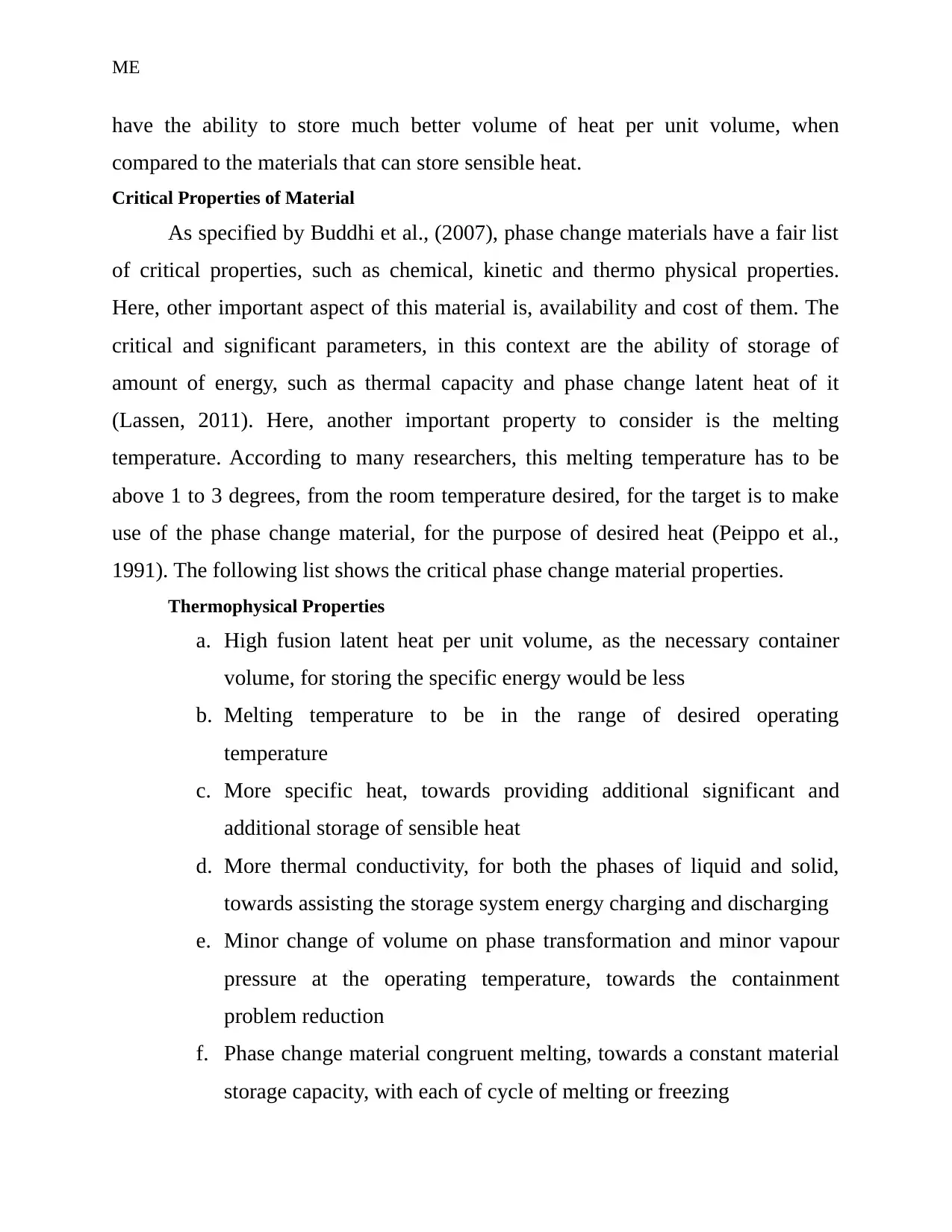
ME
have the ability to store much better volume of heat per unit volume, when
compared to the materials that can store sensible heat.
Critical Properties of Material
As specified by Buddhi et al., (2007), phase change materials have a fair list
of critical properties, such as chemical, kinetic and thermo physical properties.
Here, other important aspect of this material is, availability and cost of them. The
critical and significant parameters, in this context are the ability of storage of
amount of energy, such as thermal capacity and phase change latent heat of it
(Lassen, 2011). Here, another important property to consider is the melting
temperature. According to many researchers, this melting temperature has to be
above 1 to 3 degrees, from the room temperature desired, for the target is to make
use of the phase change material, for the purpose of desired heat (Peippo et al.,
1991). The following list shows the critical phase change material properties.
Thermophysical Properties
a. High fusion latent heat per unit volume, as the necessary container
volume, for storing the specific energy would be less
b. Melting temperature to be in the range of desired operating
temperature
c. More specific heat, towards providing additional significant and
additional storage of sensible heat
d. More thermal conductivity, for both the phases of liquid and solid,
towards assisting the storage system energy charging and discharging
e. Minor change of volume on phase transformation and minor vapour
pressure at the operating temperature, towards the containment
problem reduction
f. Phase change material congruent melting, towards a constant material
storage capacity, with each of cycle of melting or freezing
have the ability to store much better volume of heat per unit volume, when
compared to the materials that can store sensible heat.
Critical Properties of Material
As specified by Buddhi et al., (2007), phase change materials have a fair list
of critical properties, such as chemical, kinetic and thermo physical properties.
Here, other important aspect of this material is, availability and cost of them. The
critical and significant parameters, in this context are the ability of storage of
amount of energy, such as thermal capacity and phase change latent heat of it
(Lassen, 2011). Here, another important property to consider is the melting
temperature. According to many researchers, this melting temperature has to be
above 1 to 3 degrees, from the room temperature desired, for the target is to make
use of the phase change material, for the purpose of desired heat (Peippo et al.,
1991). The following list shows the critical phase change material properties.
Thermophysical Properties
a. High fusion latent heat per unit volume, as the necessary container
volume, for storing the specific energy would be less
b. Melting temperature to be in the range of desired operating
temperature
c. More specific heat, towards providing additional significant and
additional storage of sensible heat
d. More thermal conductivity, for both the phases of liquid and solid,
towards assisting the storage system energy charging and discharging
e. Minor change of volume on phase transformation and minor vapour
pressure at the operating temperature, towards the containment
problem reduction
f. Phase change material congruent melting, towards a constant material
storage capacity, with each of cycle of melting or freezing
Paraphrase This Document
Need a fresh take? Get an instant paraphrase of this document with our AI Paraphraser
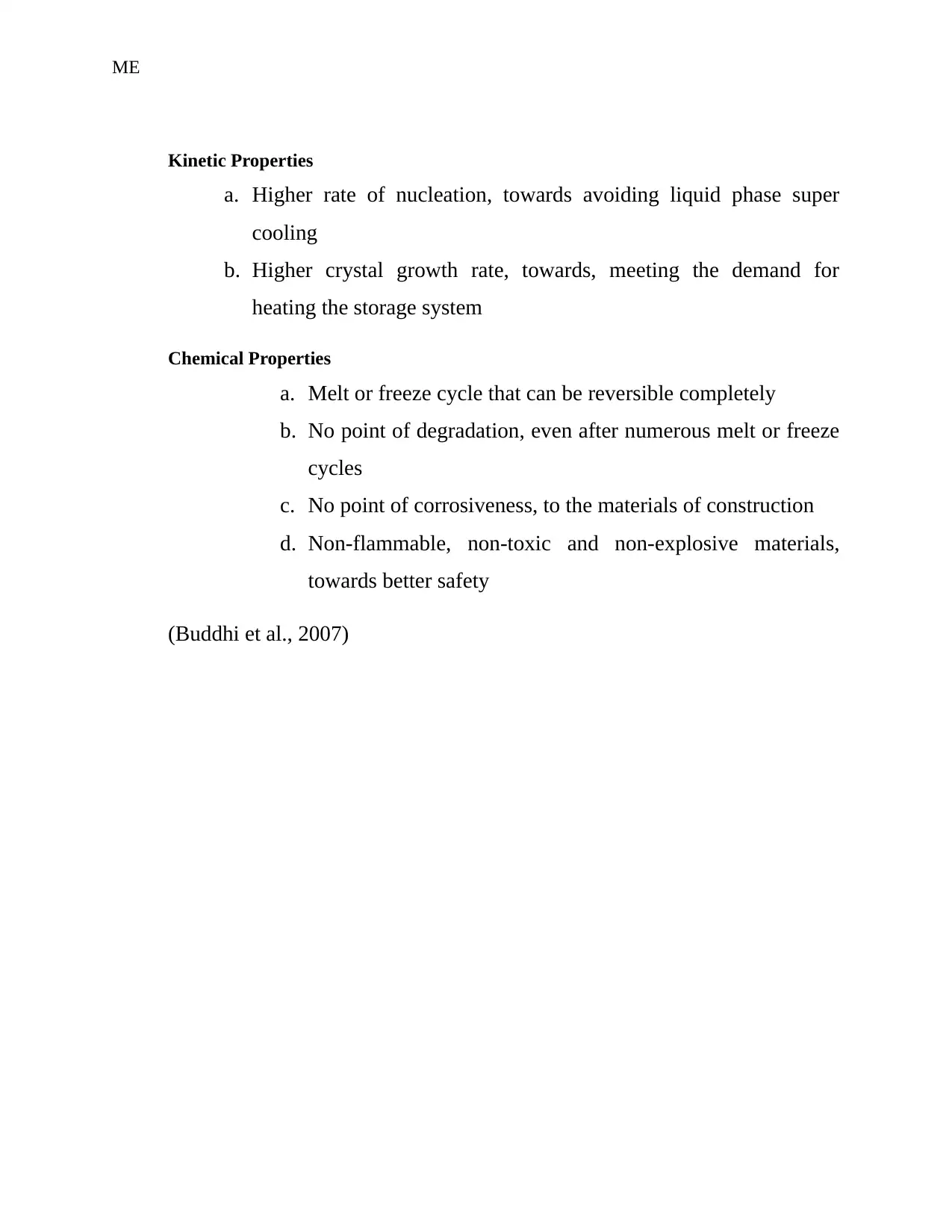
ME
Kinetic Properties
a. Higher rate of nucleation, towards avoiding liquid phase super
cooling
b. Higher crystal growth rate, towards, meeting the demand for
heating the storage system
Chemical Properties
a. Melt or freeze cycle that can be reversible completely
b. No point of degradation, even after numerous melt or freeze
cycles
c. No point of corrosiveness, to the materials of construction
d. Non-flammable, non-toxic and non-explosive materials,
towards better safety
(Buddhi et al., 2007)
Kinetic Properties
a. Higher rate of nucleation, towards avoiding liquid phase super
cooling
b. Higher crystal growth rate, towards, meeting the demand for
heating the storage system
Chemical Properties
a. Melt or freeze cycle that can be reversible completely
b. No point of degradation, even after numerous melt or freeze
cycles
c. No point of corrosiveness, to the materials of construction
d. Non-flammable, non-toxic and non-explosive materials,
towards better safety
(Buddhi et al., 2007)
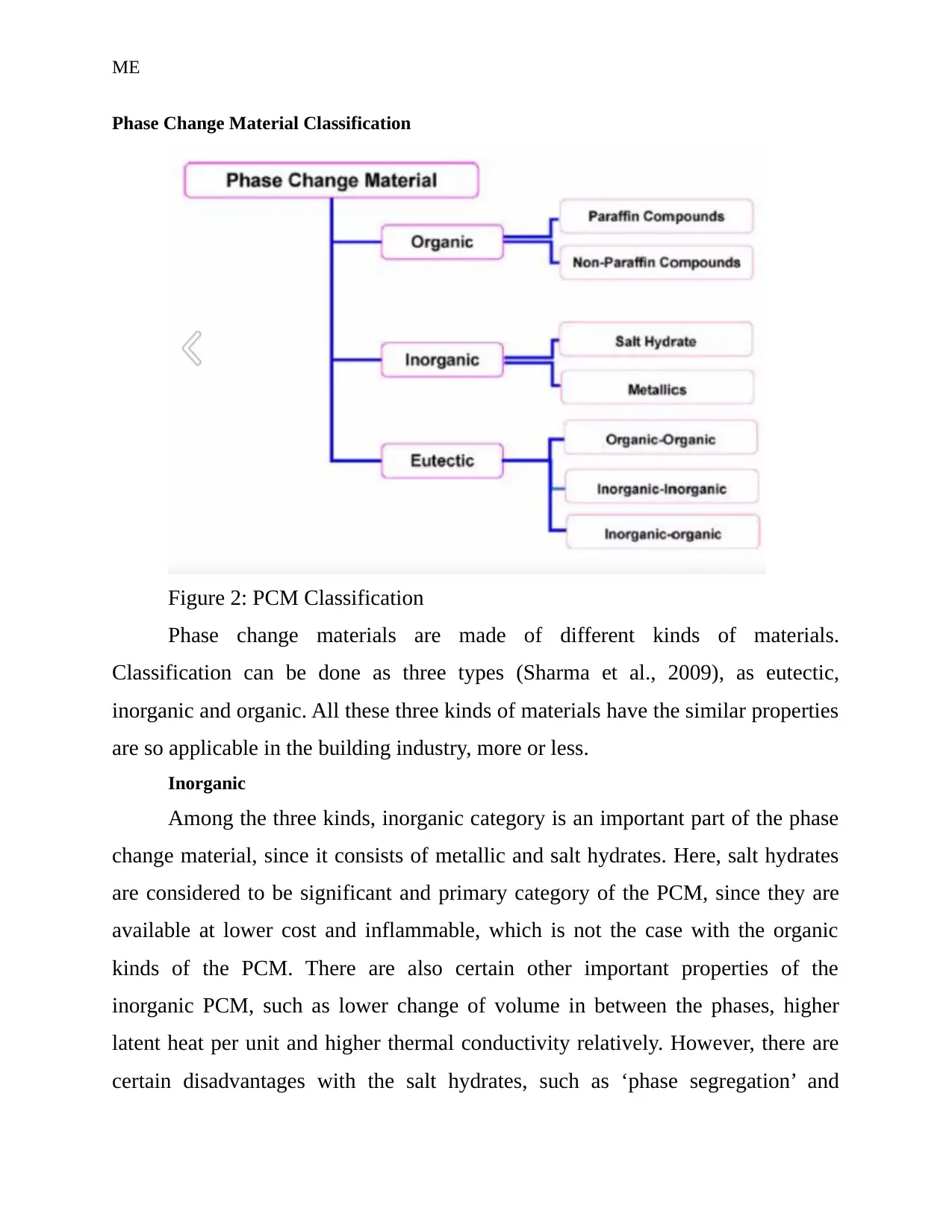
ME
Phase Change Material Classification
Figure 2: PCM Classification
Phase change materials are made of different kinds of materials.
Classification can be done as three types (Sharma et al., 2009), as eutectic,
inorganic and organic. All these three kinds of materials have the similar properties
are so applicable in the building industry, more or less.
Inorganic
Among the three kinds, inorganic category is an important part of the phase
change material, since it consists of metallic and salt hydrates. Here, salt hydrates
are considered to be significant and primary category of the PCM, since they are
available at lower cost and inflammable, which is not the case with the organic
kinds of the PCM. There are also certain other important properties of the
inorganic PCM, such as lower change of volume in between the phases, higher
latent heat per unit and higher thermal conductivity relatively. However, there are
certain disadvantages with the salt hydrates, such as ‘phase segregation’ and
Phase Change Material Classification
Figure 2: PCM Classification
Phase change materials are made of different kinds of materials.
Classification can be done as three types (Sharma et al., 2009), as eutectic,
inorganic and organic. All these three kinds of materials have the similar properties
are so applicable in the building industry, more or less.
Inorganic
Among the three kinds, inorganic category is an important part of the phase
change material, since it consists of metallic and salt hydrates. Here, salt hydrates
are considered to be significant and primary category of the PCM, since they are
available at lower cost and inflammable, which is not the case with the organic
kinds of the PCM. There are also certain other important properties of the
inorganic PCM, such as lower change of volume in between the phases, higher
latent heat per unit and higher thermal conductivity relatively. However, there are
certain disadvantages with the salt hydrates, such as ‘phase segregation’ and
⊘ This is a preview!⊘
Do you want full access?
Subscribe today to unlock all pages.

Trusted by 1+ million students worldwide
1 out of 43
Related Documents
Your All-in-One AI-Powered Toolkit for Academic Success.
+13062052269
info@desklib.com
Available 24*7 on WhatsApp / Email
![[object Object]](/_next/static/media/star-bottom.7253800d.svg)
Unlock your academic potential
Copyright © 2020–2025 A2Z Services. All Rights Reserved. Developed and managed by ZUCOL.




